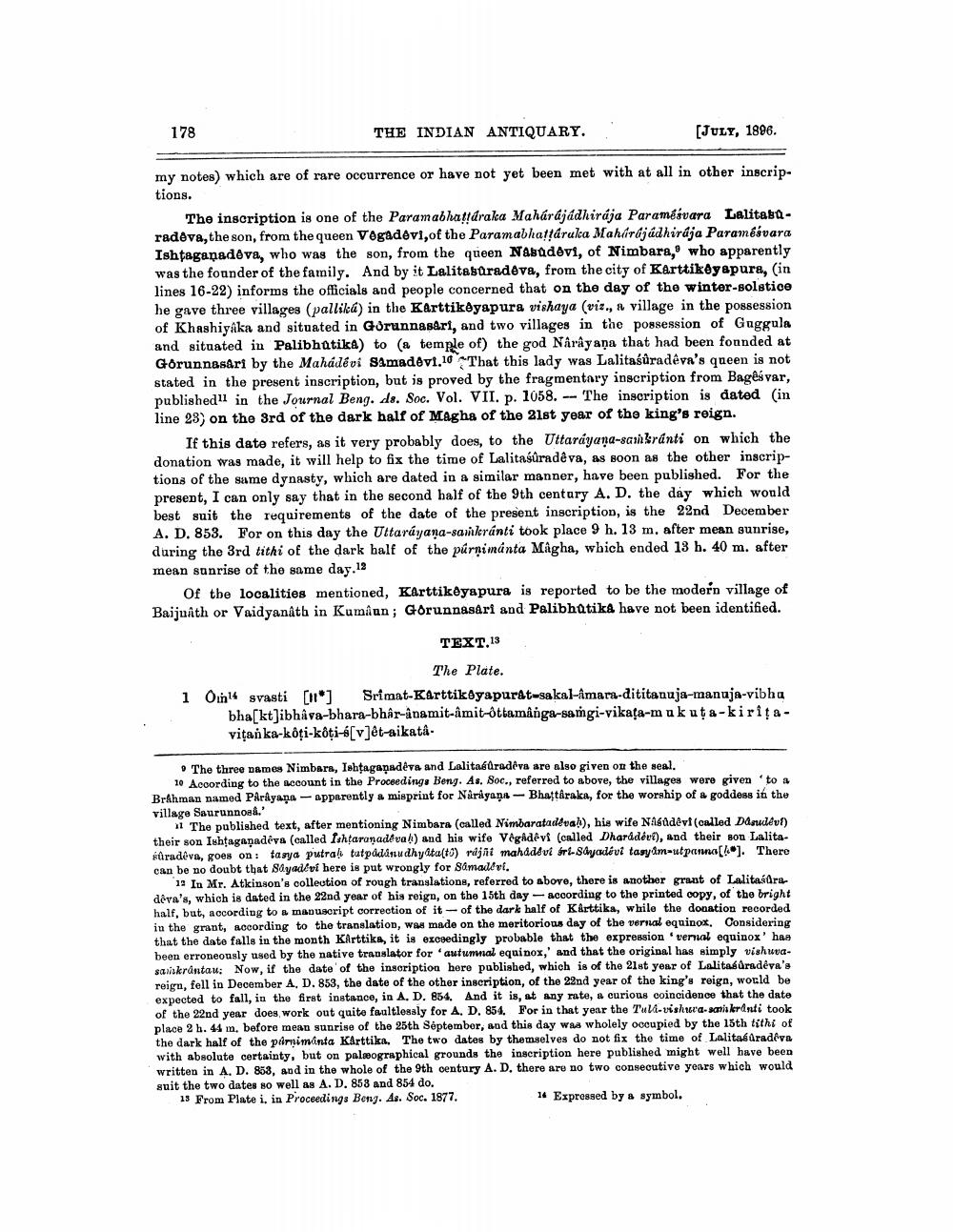________________
178
THE INDIAN ANTIQUARY.
(JULY, 1896.
my notes) which are of rare occurrence or have not yet been met with at all in other inscriptions.
The inscription is one of the Paramabhattáraka Mahárájádhiraja Paraméšvara Lalitabaradova, the son, from the queen Vågadevi, of the Paramabhattáruka Maharljádhiraja Paramésvara Ishtaganedēva, who was the son, from the queen Nasudevi, of Nimbara, who apparently was the founder of the family. And by it Lalitastradeva, from the city of Karttikėyapura, (in lines 16-22) informs the officials and people concerned that on the day of the winter-solstice he gave three villages (palliká) in the Karttikeyapura vishaya (viz., a village in the possession of Khashiyaka and situated in Gurunnasari, and two villages in the possession of Guggula and situated in Palibhutika) to (a temple of) the god Narayana that had been founded at Gorunnasari by the Mahadevi Simadevi.10 That this lady was Lalitaśůradêva's queen is not stated in the present inscription, but is proved by the fragmentary inscription from Bagésvar, published in the Journal Beng. ds. Soc. Vol. VII. p. 1058. --The inscription is dated in line 28) on the 3rd of the dark half of Maghs of the 21st year of the king's reign.
If this date refers, as it very probably does, to the Uttarayana-sarisránti on which the donation was made, it will help to fix the time of Lalitaśúradêva, as soon as the other inscriptions of the same dynasty, which are dated in a similar manner, have been published. For the present, I can only say that in the second half of the 9th century A. D. the day which would best suit the requirements of the date of the present inscription, is the 22nd December A. D. 853. For on this day the Uttaráyana-saukránti took place 9 h. 13 m. after mean sunrise, during the 3rd tithi of the dark half of the púrnimánta Magha, which ended 13 b. 40 m. after mean sunrise of the same day.12
Of the localities mentioned, Karttikėyapura is reported to be the modern village of Baijuath or Vaidyanath in Kumûan; Gorunnasäri and Palibhatika have not been identified.
TEXT.13
The Plate. 1 Oin svasti [1] Srimat-Karttiksyapurat-sakal-Amara-dititanuja-manuja-vibha
bhaktibhava-bhara-bhar-idamit-amitôttamanga-sagi-vikața-m akute-kiritavitan ka-koti-koti-6[v]êt-aikata.
The three Dames Nimbara, Ishtagapadeva and Lalitaédraders are also given on the seal. 10 According to the account in the Proceedinge Beng. As. Soc., referred to above, the villages were given to a Brahman named Påråyana - apparently a misprint for Nårågans - Bhattaraka, for the worship of a goddess in the village Saurunnoad.'
1 The published text, after mentioning Nimbara (called Nimbarataddual), his wife NASddevl(called Daoulavi) their son Ishtagañadeva (called Ishtaronadeval) and his wife Véghdevi (called Dharddéve), and their son Lalitasûradeva, goes on: tasya putrah tatpadanudhyata(t)) rájni mahadevi Srl-Sayadevi tasyam-utpanna[l]. There can be no doubt that Sayad vi here is put wrongly for Samallvi.
12 In Mr. Atkinson's collection of rough translations, referred to above, there is another great of Lalitaádre deva's, which is dated in the 22nd year of his reign, on the 15th day according to the printed copy, of the bright half, but, according to a manuscript correction of it of the dark half of Kårttika, while the donation recorded in the grant, according to the translation, was made on the meritorious day of the vernal equinox. Considering that the date falls in the month KArttika, it is exceedingly probable that the expression 'veral equinox' has been erroneously used by the native translator for 'autumnal equinox,' and that the original has simply vishuvasankrantau: Now, if the date of the inscription here pablished, which is of the 21st year of Lalitabúradéva's reign, fell in December A, D. 853, the date of the other inscription, of the 22nd year of the king's reign, would be expected to fall, in the first instance, in A. D. 854. And it is, at any rate, a curious coincidence that the date of the 22nd year does, work out quite faultlessly for A. D. 854. For in that year the Tuli-vissera-soniskrauti took place 2 h. 44 m, before mean sunrise of the 25th September, kod this day was wholely occupied by the 15th tithi of the dark half of the pamimanta Karttika. The two dates by themselves do not fix the time of Lalitas dradeva with absolute certainty, but on paleographical grounds the inscription here published might well have been written in A. D. 853, and in the whole of the 9th century A. D. there are no two consecutive years which would suit the two dates so well as A. D. 858 and 854 do. 13 From Plate i. in Proceedings Beng. As. Soc. 1877.
14 Expressed by a symbol.




